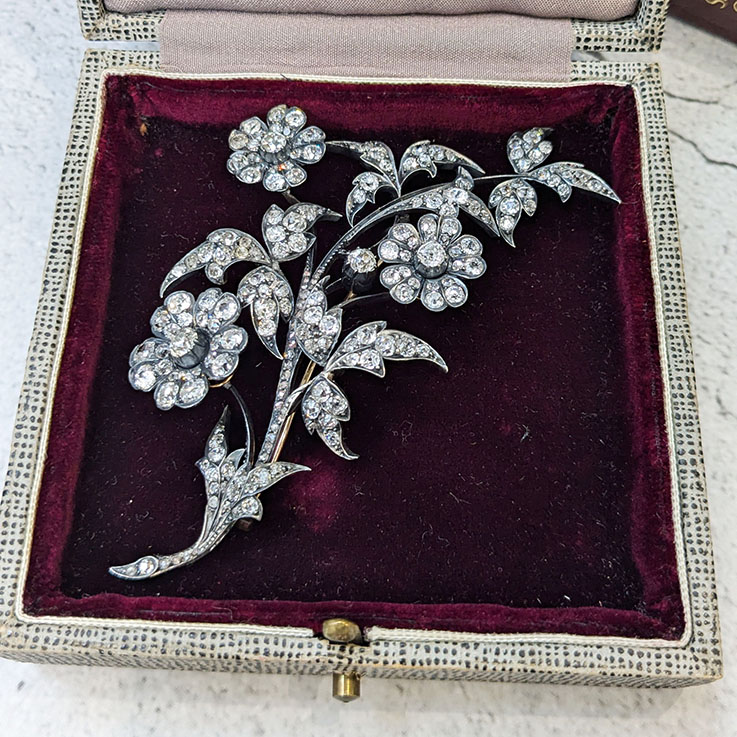Coral
Antique Victorian Coral and Gold Snake Cufflinks
The Victorian Jewellery period coincided with the reign of Queen Victoria from 1837 – 1901 and is often associated with romance and grandeur, in art, literature and music as well as jewellery
Queen Victoria loved jewellery and wore a lot of it, both formal and informal, and naturally the styles of the court were copied by everyone else. She is credited with inspiring the popularity of snake jewellery, one of the motifs closely associated with the era, after being given a snake ring by Prince Albert on their engagement.
The Victorian era can be broken down into 3 distinct periods and the notable style changes between them.
Early Victorian – The Romantic Period (1837 – 1861)
Mid Victorian – The Grand Period (1861 – 1885)
Late Victorian – The Aesthetic Period (1885 – 1901)
Early Victorian jewellery was an elegant period, deeply influenced by the Young Queen and her love for her husband, Prince Albert.
Creative inspiration also came from the Renaissance and Middle Ages, along with the natural world, with pieces holding symbolic meaning.
This period saw considerable development in how pieces were made, and gold became a more prevalent construction material.
Queen Victoria inspired the popularity of snake jewellery, after being given a snake ring by Prince Albert on their engagement. It was in 1840 when snake jewellery made its peak in popularity.

Naturalism was a strong theme throughout the Victorian era with flowers, birds, insects and animals frequently depicted in a number of different styles
From small bar brooches and stick pins with gem-set pheasants and dragonflies or fox heads in carefully engraved and painted Essex crystals through to huge diamond corsages designed as sprays of flowers set en tremblant so they moved with the wearer. Victorian jewellery is alive with flora and fauna.

Other materials and gemstone also used in this period: Agate, Amber, Amethyst, Chalcedony, Chrysoberyl, Emerald, Red Coral, Malachite, Quartz and Topaz.
Materials: Enamel, Ivory, Lava Stone, and Tortoiseshell

Antique Victorian Coral and Gold Snake Cufflinks
Victorian Antique Demantoid Garnet and Pearl Pendant Brooch
Antique Victorian Turquoise and Diamond Sweetheart Ring
After the death of Prince Albert in 1861, Queen Victoria was left mourning the loss of the love of her life, ended the Romantic period. Queen Victoria grieved deeply and her mourning period spanned more than 40 years until her death. The Grand Period saw the reignition of the use of mourning jewellery, mostly crafted from jet or onyx and often containing locks of hair.
This period also had a dramatic change in design. Changes in social roles were reflected in jewellery design, which shifted from delicate to bold.
Increased wealth and the rise of the middle classes ignited a widespread interest in travel with many people taking “The Grand Tour of Europe”. Buying souvenir jewellery became a popular way of remembering the places visited and Italy, in particular, produced a wide variety of jewellery for the tourist market.
Fringe necklaces made from native corals, cameos carved from lava, bracelets and brooches depicting cultural landmarks in micromosaic or floral arrangements in pietra dura were all popular mementos.
Perhaps the most famous of this type of jewellery was made by Castellani in Rome who was producing intricate and detailed goldwork pieces in an archaeological revival style that became very fashionable in England and even America.
This period also saw prominent imitations of fine jewellery and, in the process, the origination of costume jewellery.
Antique Victorian 2.60ct Old Cut Diamond and Pearl Forget Me Not Onyx 18ct Gold Necklace
Antique Victorian 18ct Yellow Gold And Black Enamel Mourning Ring
Antique Victorian Garnet and Turquoise Locket Pendant
The Aesthetic Period was primarily an art movement, valuing the appearance of the arts (literature, music and so on) over their function, and encouraged freedom of thought. Items were produced just to be beautiful, and by the 1890’s, decadence was in use across Europe.
Romantic styles reappeared; with hearts, roses and butterflies reignited in popularity

Jewellery was made purposefully for special occasions, with glamour and drama at the forefront of design.

Popularity of mourning and memorial jewellery remained strong, with designs becoming more elaborate and colourful
